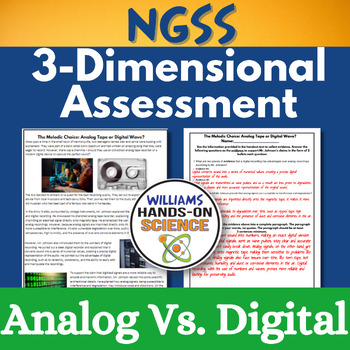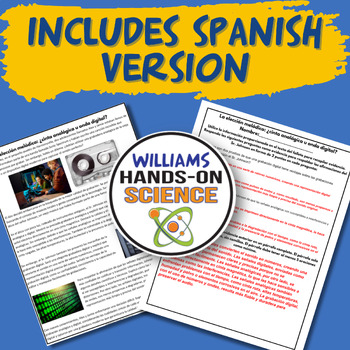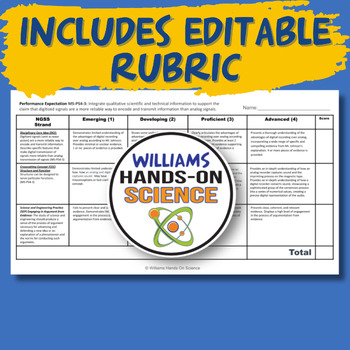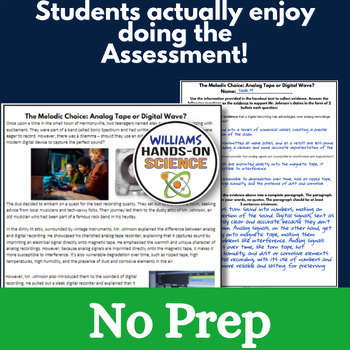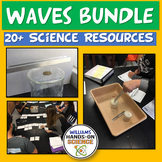CER Analog V Digital NGSS 3 Dimensional Assessment MS-PS-4-3 Spanish Test Prep
- Google Drive™ folder

Also included in
- Waves can be so fun, and your students will marvel at the power of what waves can do! This is a growing bundle with 20+ resources and growing. I’m an NGSS leader in my district, so the resources are phenomena based and contain the three dimensions of learning the NGSS requires. AND! It Includes ESL/Price $55.00Original Price $105.00Save $50.00
Description
Struggling to create an NGSS 3-Dimensional assessment? This resource features an engaging assessment aligned with the Next Generation Science Standards (NGSS), integrating disciplinary core ideas, crosscutting concepts, and science and engineering practices. With a focus on depth of understanding, critical thinking, and application of knowledge, this assessment empowers students to master key concepts on the differences between Analog and Digital signals, while preparing them for real-world challenges. AND IT INCLUDES A SPANISH VERSION FOR YOUR ESL/ELL/NEWCOMERS!
What Students Do:
Reading: Disciplinary Core Idea (DCI): Digitized signals (sent as wave pulses) are a more reliable way to encode and transmit information. Describe specific features that make digital transmission of signals more reliable than analog transmission of signals (MS-PS4-3). Students read the story of two aspiring musicians facing a crucial decision: whether to record their latest track using the vintage charm of an analog device or the modern efficiency of a digital recorder. Seeking guidance, they turned to Mr. Johnson, a seasoned local musician. With a calm demeanor, Mr. Johnson explained the merits of digital superiority, where signals flow effortlessly as precise numerical values, contrasting with the shortcomings of analog signals, which are prone to interference and degradation.
Claim Evidence Reasoning: Science and Engineering Practice (SEP) Engaging in Argument from Evidence: The study of science and engineering should produce a sense of the process of argument necessary for advancing and defending a new idea or an explanation of a phenomenon and the norms for conducting such arguments. Students receive two claims from Mr. Johnson asserting the reliability of digital signals and two claims stating the inferiority of analog signals. Their task is to locate four pieces of evidence within the reading that support Mr. Johnson's claims. Students compile these pieces of evidence into a cohesive paragraph in the reasoning section, presenting a comprehensive argument bolstered by the evidence provided in the text.
This product Includes the following:
-Student copy in Spanish and English
-Reading Passages in Spanish and English
-Answer key in Spanish and English
-Editable Rubric
Includes the following concepts:
-Claim
-Evidence
-Reasoning
-Analog Signals
-Digital Signals
-Digital converts sound into a series of numerical values, creating a precise digital representation of the audio.
-Digital signals are transmitted as wave pulses, and as a result are less prone to degradation, providing a cleaner and more accurate representation of the original sound.
-Because analog signals are imprinted directly onto the magnetic tape, it makes it more susceptible to interference.
-Analog signals are vulnerable to degradation over time, such as ripped tape, high temperatures, high humidity, and the presence of dust and corrosive elements in the air.
Want some freebies? Go to williamshandsonscience.com
Includes the Following NGSS Standards:
PS4.C: Information Technologies and Instrumentation
Digitized information can be transmitted over long distances without significant degradation. High-tech devices, such as computers or cell phones, can receive and decode information—convert it from digitized form to voice—and vice versa.
(4-PS4-3)
Science and Engineering Practice (SEP) Engaging in Argument from Evidence:
The study of science and engineering should produce a sense of the process of argument necessary for advancing and defending a new idea or an explanation of a phenomenon and the norms for conducting such arguments.
Crosscutting Concept (CCC)
Structures can be designed to serve particular functions. (MS-PS4-3)
TERMS OF USE
• All rights reserved by Williams Hands On Science, Inc.
• This product is to be used by the original purchaser only.
• Intended for classroom and personal use only.
• Copying for more than one teacher, classroom, department, school, or school system is prohibited.
• This product may not be distributed or displayed digitally for public view.
• Failure to comply is a copyright infringement and a violation of the Digital Millennium Copyright Act (DMCA).
If there are any errors or questions, please contact me through TpT or email me at:
williamshandsonscience@gmail.com
Thank you for taking a look!
Please follow me on TpT for new products and check me out on Instagram for my products in action!
https://www.instagram.com/williams_hands_on_science/

